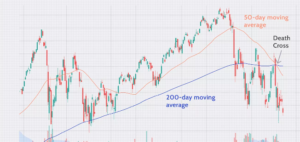The death cross strategy is widely used in technical analyses to get an idea about the current trend in the index or stock. The death cross is an indicator that can be used to decide down trend of stock or index. This indicator makes use of short-term and long-term moving averages. When a long-term moving average crosses above a short-term moving average, it signals a shift in stock or index sentiment from bullish to bearish.
The most common moving averages used in a Death Cross are:
- 50-day moving average (short-term)
- 200-day moving average (long-term)
Phases of the Death Cross:
Uptrend Ending: During this phase, the price remains uptrending and the long-term moving average is below the short-term moving average. The gap between the short and long moving averages is getting reduced in this phase.
Crossover: In this phase, the longterm moving average crosses above the short-term moving average; this signifies a shift in the momentum, and it starts moving downward.
Downward Begins: After the crossover phase, the price often enters a downward trend as bearish sentiment strengthens.

Interpretation:
Bearish signal: Traders view the Death Cross as a sell signal and can expect further down in the price.
Confirmation: Along with the death crossover, it is also recommended to check the rise in volume, which indicates strong market participation by big institutions like DII and FII.
We must make note that death crossover does not always guarantee a fall in the price. One should also consider some other indicators to support a downtrend; some of the widely used such indicators are listed below.
1 Relative Strength Index (RSI)
2 Moving Average Convergence Divergence (MACD)
3 On-Balance Volume (OBV)
4 Stochastic Oscillator
5 Bollinger Bands
Note: You can also read about the opposite of the death cross strategy, i.e., the golden cross strategy.
Limitation of Death Cross strategy:
1 Lagging Indicator: The death cross is based on historical moving average data, so by the time it has formed the death cross, some portion of the downward movement may already have occurred, hence reducing the overall potential of profit.
2 False Signals: During the volatile or sideways market siltation, the Death Cross strategy may result in whipsaws—frequent false signals that cause traders to buy or sell at the wrong price, which eventually leads to losses.
3 Ignorance of Market Fundamentals: The Death Cross strategy is purely a technical signal and ignores all the important macroeconomic conditions, company-related news/data, or broader market trends that may affect price fluctuation.
Conclusion:
The death crossover strategy can be used by traders to confirm the bearish trend along with some other widely used indicators.
